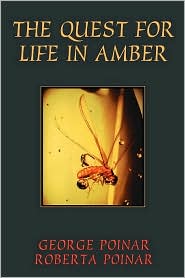






 ANCIENT DNA HIGHLIGHTS

|
Crichton's Jurassic Park popularized the idea of extracting dinosaur DNA from insects trapped in ancient amber. Yet as early as 1965, a scientist named Philip Abelson published an article in Scientific American, reporting intact amino acids found in fossils millions of years old. Even further, he used rapid degredation testing to infer that the amino acid alanine could remain stable and intact for billions of years. We now know that dinosaur amino acid sequences and perhaps even genetic material may be available from other sources, particularly the interiors of fossilized dinosaur bones. Recently Mary Schweitzer (North Carolina State University) reported that she found soft tissue, even blood vessels, in the fossilized bone of a T. Rex. Schweitzer's discovery only adds to the list of places we might find preserved organic material, which already includes ancient amber, ice beds, and the genomes of modern organisms. "Sometimes science imitates science fiction. In 1994, four years after Jurassic Park was published, and a year after the Jurassic Park movie was released, Scott Woodward at Brigham Young University reported the recovery of DNA from eighty-million-year-old fragments of dinosaur bone found in a Utah coal mine. The report was quite a surprise. Crichton put the preserved dinosaur DNA in Jurassic Park in the gut of a mosquito safely encased in fossilized tree resin because that was far more believable than dinosaur DNA being recovered from a fossil bone buried for tens of millions of years." This method of dinosaur resurrection offers the greatest potential for an "authentic" dinosaur because we're going to the original source for the genetic material. Whatever genetic material we've found so far, it's not nearly enough, and we may never have enough to build even a partial genome. In any case, modern cloning technologies would demand that we create a hybrid organism, such as crossing dinosaur DNA with the genes of a surrogate emu, or mammoth DNA with that of an elephant. Despite several reports over the years, and even assuming some proteins have been found intact, there are no confirmed discoveries of dinosaur DNA...yet?  |
|
|
T. Rex Blood? Preserved soft tissue, including possible blood vessels and red blood cells, are turning up in dinosaur fossils (NOVA scienceNOW) Watch the full episode. See more NOVA scienceNOW. |
|
| |
60 Minutes - B. Rex |
Tim Rowe (University of Texas) |
